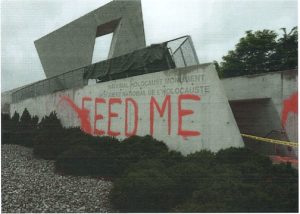 Israel’s foreign minister, Tzipi Livni, recently invited 70 ambassadors posted to Israel for a tour of its volatile border area opposite the Gaza Strip.
Israel’s foreign minister, Tzipi Livni, recently invited 70 ambassadors posted to Israel for a tour of its volatile border area opposite the Gaza Strip.
Her aim was to warn them that Israel can no longer tolerate the “unbearable” fusillade of Qassam rocket and mortar barrages. Sderot, a town about one kilometre from Gaza, has borne the brunt of these attacks, but the neighbouring city of Ashkelon, as well as kibbutzim in the vicinity, have also been struck. These bombardments, which have escalated in frequency and lethality since Israel’s unilateral withdrawal from Gaza in 2005, have been launched by a loose coalition of radical Palestinian organizations from Islamic Jihad to Hamas in the face of official opposition from the Palestinian Authority. Since 2001, the second year of the current Palestinian uprising, these groups have fired thousands of projectiles into Israel, killing 13 civilians and wounding hundreds more.
During the visit, Livni told the envoys that Israel has no choice but “to act in order to reduce these threats.” Her message was clear: Israel is seeking understanding, if not actual support, for a major ground offensive into Gaza to obliterate this reign of terror.
Whether Israel unleashes the full might of its armed forces in an attempt to crush this form of terrorism is an open question, since this problem is probably outside the realm of a cut-and-dried military solution.
But in the meantime, the Israeli army is on the offensive, conducting shallow-penetration raids into Gaza on almost a daily basis. These raids are designed to push the Qassam and mortar launching teams further away from the frontier, to prevent Palestinian militants from crossing into Israel and attacking settlements and laying roadside bombs, to uncover and destroy arms smuggling tunnels, and to disrupt attempts to abduct Israeli soldiers. In these operations, Israel has killed some 200 Palestinian fighters in the past few months.
Israel has been here before. Two years ago, after Palestinian gunmen stormed an Israeli border outpost and killed several troops and kidnapped a soldier named Gilad Shalit, Israel launched a series of incursions into Gaza that resulted in the deaths of more than 100 Palestinian militants. These raids had no lasting effect. The bombardments continued and Shalit remains imprisoned in Gaza.
Today, confounded by its failure to staunch the incessant attacks, Israel has stepped up the pace of targeted assassinations against key Palestinian figures involved in the design, manufacture, transport and firing of Qassams and mortars. Israel has also gone after key Hamas commanders. Last September, Israeli commandos captured Mahawesh el-Qadi, who is believed to have played a role in Shalit’s abduction. More recently, Israel has again threatened to kill the Hamas political leadership. In 2004, Israel killed Hamas’ founder and spiritual leader, Sheikh Ahmed Yassin, and his deputy, Abdel Aziz Rantisi. Three weeks ago, Israeli Transportation Minister Shaul Mofaz, the former defence minister, called for the assassination of Mahmoud Zahar, Hamas’ former foreign minister, prompting Hamas leaders to adopt a low profile and go into hiding.
In addition, Israel has arrested 41 Hamas parliamentarians, who acquired their seats in free and fair Palestinian national elections in January 2006. (Hamas won 74 of 132 seats, due in large part to the perception that its chief adversary, Fatah, was hopelessly mired in corruption and cronyism, that its economic policies had failed, and that it was incapable of forming a Palestinian state. )
Having made no secret of its intention to weaken Hamas since its takeover of Gaza last June, Israel has imposed a blockade, closed border crossings, branded Gaza as an “enemy entity,” cut off the flow of virtually all goods except food and medical supplies, and curtailed the sale of fuel and electricity. The Israeli government intends to keep Hamas off balance until it ceases attacks and, in line with international demands, recognizes Israel’s existence, renounces terrorism and accepts agreements signed by Israel and the Palestinian Authority since the 1993 Oslo peace process.
Israel’s policies, which have been described as a “declaration of war” by Hamas and denounced by the Palestinian Authority, have aroused the ire of the United Nations Secretary General Ban Ki-moon, who has said that the cutoff of vital services is contrary to international law. Ban contends that, since Israel is still in charge of Gaza’s border crossings, air space and coast, Israel is responsible for the well-being of its besieged population.
Ban’s deputy, John Holmes, who visited the region two weeks ago, has said that life in Gaza is “grim and miserable” and has urged Israel to lift the closure. Israel is unlikely to comply, given the fact that there has been no letup in Palestinian rocket and mortar attacks and attempted border infiltrations, and that Ismail Haniyeh, the Hamas prime minister, has reiterated his belief that his movement should never recognize Israel. In light of this situation, Israel is moving closer to invading Gaza.
For the past few months, top Israeli officials have issued unmistakable warnings that an invasion is drawing near. Last October, Defence Minister Ehud Barak said, “Every day that passes brings us closer to a broad operation in Gaza.” On Feb. 5, after Hamas, the Popular Front for the Liberation of Palestine and the Al Aqsa Martyrs Brigades took joint credit for a suicide bombing in Dimona – the first such attack in a year – Barak promised that he would crush terrorism. On Feb. 12, he said, “We will be forced to strengthen our military efforts.” Yet Barak – whose dire warnings have been echoed by Minister of Public Security Avi Dichter – says that he will not order an invasion unless Israel defines its goals, receives broad support and has an exit strategy. These considerations do not seem to bother Israel’s deputy prime minister, Haim Ramon, who has vowed to escalate the war with Hamas and observed that “a combination of steps will bring an end to the Hamas regime in Gaza” within a year. The chief of staff, Gen. Gabi Ashkenazi, has weighed in, too, saying that he is “prepared and ready to deepen and expand operations in Gaza as much as necessary.” Prime Minister Ehud Olmert, however, has been circumspect, saying “there is no way to put an absolute end to the terrorism in a single blow” and pointedly arguing that “rage is not a plan.”
An invasion of Gaza would presumably be modeled after Operation Defensive Shield, during which Israel reoccupied the West Bank in March and April 2002. Israel’s reoccupation of Gaza would be costly for both sides. Hamas, having taken a page out of Hezbollah’s textbook for waging guerrilla warfare, has constructed a web of fortifications throughout Gaza. These positions would be manned by 50,000 men and hundreds of suicide bombers, says Nizar Rayyan, a senior Hamas official. Thanks to a network of tunnels, Hamas has managed to smuggle advanced weapons – long-range rockets, anti-tank missiles and anti-aircraft missiles – into Gaza, according to Yuval Diskin, the director of Israel’s internal security service. Last month, Hamas allegedly smuggled in yet more arms – and Iranian-trained personnel – into Gaza by blowing up parts of the separation wall that cuts off Gaza from Egypt.
Israel does not have to invade Gaza to pacify its southern border. A long-term truce with Hamas might be sufficient. Hamas has generally expressed interest in a ceasefire, but Israel does not want to negotiate with Hamas. In the interim, Israel is working on alternative methods to enhance its security. Israel is fortifying homes in Sderot and developing the Iron Dome, an anti-missile system that may yet neutralize Qassams and mortars. Israel is also building a separation fence along the Egyptian border. But until then, Israel will have to endure a rain of rockets and mortars.






